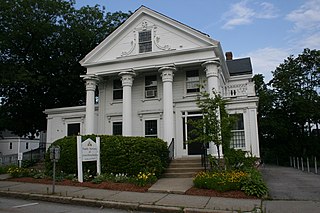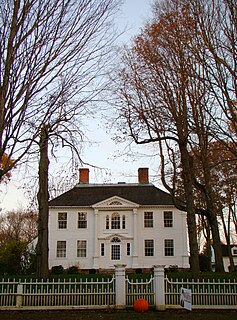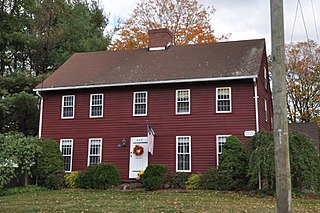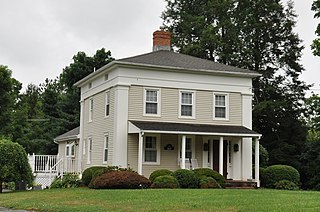
The Edward Augustus Russell House is a Greek Revival house on the Wesleyan University campus in Middletown, Connecticut, USA. The house, at 318 High Street, faces west from the east side of High Street north of the corner at High and Court Streets. A large wooded lawn extends to the Honors College property to the north. High Street between Church and Washington Streets was the most prestigious residential area in Middletown during the 19th century. It was later home to the KNK Fraternity of Wesleyan University. The structural system consists of load-bearing masonry with a flat roof, and materials include brick and flushboarding walls and a brownstone foundation.

The Samuel Wadsworth Russell House is a neoclassical house at 350 High Street in Middletown, Connecticut, built in 1828 to a design by architect Ithiel Town. Many architectural historians consider it to be one of the finest Greek Revival mansions in the northeastern United States. Town's client was Samuel Wadsworth Russell (1789-1862), the founder of Russell & Company, the largest and most important American firm to do business in the China trade in the 19th century, and whose fortunes were primarily based on smuggling illegal and addictive opium into China.

The Greenville Presbyterian Church is located on NY 32 just north of its intersection with NY 81 in Greenville, New York, United States. Its three buildings on two acres were listed on the National Register of Historic Places (NRHP) in 1985.

The Samuel Copeland House is a historic house located at 31 Harvard Street in Worcester, Massachusetts. Built c. 1847, the elaborate Greek Revival house is one two in the city with a full temple front. The house was listed on the National Register of Historic Places on March 5, 1980.

The E. B. Cummings House is a historic house at 52 Marcy Street in Southbridge, Massachusetts. Built in the 1870s, it is an unusually late example of Greek Revival architecture with Italianate embellishments and later Victorian additions. The house was listed on the National Register of Historic Places on June 22, 1989.

The Tousley-Church House is located on North Main Street in Albion, New York, United States. It is a brick house in the Greek Revival architectural style built in two different stages in the mid-19th century.

The United States Customhouse is a historic and active custom house at 2nd and William Streets in New Bedford, Massachusetts. Architect Robert Mills designed the custom house in 1834 in a Greek Revival style. It has been used by the U.S. Customs Service ever since, and today serves as a port of entry.

The Capt. John Clark House is a historic house on the east side of Connecticut Route 169, south of Canterbury, Connecticut. This c, 1800 enlargement of an older house is a finely crafted example of a locally distinctive style known as the "Canterbury style". The house was added to the National Register of Historic Places in 1970.

The Church of the Good Shepherd and Parish House is an Episcopal church at 155 Wyllys Street in Hartford, Connecticut. It was commissioned by Elizabeth Jarvis Colt, the widow of Samuel Colt, and completed in 1867. The church and its associated parish house were designed by Edward Tuckerman Potter, and serve as a memorial to Samuel Colt and members of his family. The church and parish house were added to the National Register of Historic Places in 1975, and became a contributing property to the Coltsville Historic District in 2008.

The Uncasville School is a historic school building at 310 Norwich-New London Turnpike in the Uncasville section of Montville, Connecticut. Designed by architect Wilson Potter, it was built during 1917-1918 by local contractor H. R. Douglas. In 1925 it was expanded by a major addition. A fine local example of Renaissance Revival architecture, its construction was funded by Grace Palmer Melcer, the daughter of a local industrialist. The building was added to the National Register of Historic Places in 2001. The building now houses town offices.

The Josiah Wilcox House is a historic house at 354 Riversville Road in Greenwich, Connecticut. Built in 1838, it is one of the town's finest examples of Greek Revival architecture. It was listed on the National Register of Historic Places in 1988.

Dr. Henry Skelton House is a historic house at 889 South Main Street in Southington, Connecticut. Built about 1748, it is a well-preserved example of colonial Georgian architecture. It was listed on the National Register of Historic Places in 1989.

The Capt. Samuel Woodruff House is a historic house at 23 Old State Road in Southington, Connecticut. Built about 1840, it is a well-preserved and somewhat rare example of a square Greek Revival farmhouse. It was listed on the National Register of Historic Places in 1989.

The Moses Camp House is a historic house at 682 Main Street in the Winsted area of Winchester, Connecticut. Probably built about 1840 for one of the region's major merchants, it is a high quality example of Greek Revival architecture. It was listed on the National Register of Historic Places in 1984; it now houses professional offices.

The Burritt Hotel was a historic hotel at 67 West Main Street in New Britain, Connecticut, United States. Built in the 1920s to attract business travelers, it was the city's most luxurious hotel. It is now Burritt House, an affordable housing complex. The building was listed on the National Register of Historic Places in 1983.

The Bushnell-Dickinson House is a historic house at 170 Old Post Road in Old Saybrook, Connecticut. With a construction history dating to about 1790, it is a fine local example of Federal period residential architecture. The house was listed on the National Register of Historic Places in 1978.

The Dr. Andrew Castle House, also known as the Castle-Russell House, is a historic house at 555 Amity Road in Woodbridge, Connecticut. Built in 1838, it is a locally distinguished example of high-style Greek Revival architecture, and is notable as the home of three prominent local physicians. It was listed on the National Register of Historic Places in 2000.

The Reuben Curtiss House is a historic house at 1770 Bucks Hill Road in Southbury, Connecticut. With a construction and alteration history dating from the late 18th to 20th centuries, the house is one of Southbury's finest examples of residential Greek Revival architecture. It was listed on the National Register of Historic Places in 1993.

The Downtown Seymour Historic District encompasses most of the historic downtown of Seymour, Connecticut. Sandwiched between Connecticut Route 8 and the tracks of the former Naugatuck Railroad line, now the Waterbury Branch, it developed in the mid-19th century as a successful industrial center dominated by the production of brass goods. The district was listed on the National Register of Historic Places in 1983.

The Samuel Parsons House is a historic house museum at 180 South Main Street in Wallingford, Connecticut. Built about 1770, it is a well-preserved example of Georgian residential architecture. It has housed the local historical society since 1919. It was listed on the National Register of Historic Places in 1982.






















